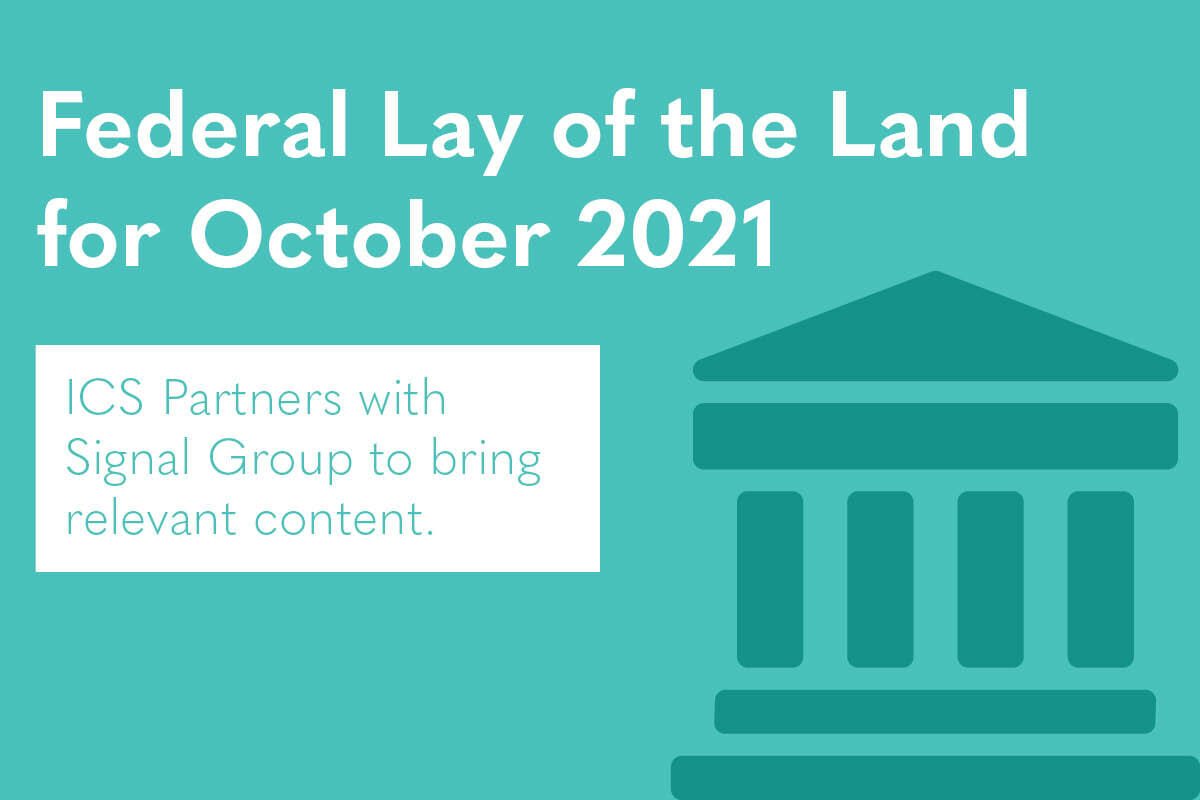In collaboration with Signal Group, here’s the Federal Lay of the Land for October 2021. For more information, please reach out to Dave Bergeron at dave.bergeron@ics-builds.com.

Economic Markers
Gross Domestic Product: The latest data from the Bureau of Economic Analysis estimated that U.S. GDP grew at an annual rate of 6.7% in the second quarter of 2021, according to the third estimate released. This growth rate is an increase over last month’s, second estimate that showed an increase in real GDP at 6.6%. The increase in this month’s third estimate is attributable to more complete source data.
BEA will release its advance estimate of Q3 GDP on October 28, 2021.
Employment: According to data from the Bureau of Labor Statistics, the unemployment rate decreased by 0.4% in September, falling from 5.2% to 8%. The number of unemployed persons edged down by roughly 710,000 to 7.7 million. While unemployment rates are improving, rates remain elevated from their pre-COVID, February 2020, levels of 3.5% and 5.7 million.
Employment in manufacturing increased by 26,000 in September, with fabricated metal products seeing 8,000 new jobs. Construction employment also grew by 22,000 in September. Both manufacturing and construction jobs remain significantly lower than their February 2020 levels, with manufacturing still down by 353,000 and construction down by 201,000.
BLS will release the Employment Situation for October on November 5, 2021.
Inflation Concerns: According to the Bureau of Labor Statistics’ latest Consumer Price Index (CPI) data released on October 13, price levels rose 0.4% (seasonally adjusted) between August and September and are up 5.4% (before seasonal adjustment) compared to September Food and shelter contributed to more than half of the increase in inflation.
BLS will release August’s CPI numbers on November 10, 2021.
Prices for steel continue to rise, increasing 5.0% in September, following a 5.1% increase in August. Prices for lumber, on the other hand, have dropped 4.3% since August.
Struggling supply chains continue to be a key challenge impacting inflation. As bottlenecks linger, both consumers and businesses are shifting their behaviors. In particular, businesses have shifted from ordering just in time, to ordering just in case, leading to higher consumer prices. While the Biden administration hoped to ease delays by brokering a deal under which the Port of Los Angeles – the busiest port in the U.S. – would expand its operating window to 24/7, skeptics are unsure that this will meaningfully improve bottlenecks because of backlogs in trucking and rail.
Contrary to forecasting, prices are both rising higher, and staying high longer. Future price increase forecasts vary, with some expecting prices to remain high, and others expecting a level out over the next 12 months.
Infrastructure Spending
Lawmakers on Capitol Hill are continuing infrastructure spending negotiations into yet another month.
It has now been over 2 months since the Senate passed the bipartisan Infrastructure Investment and Jobs Act (IIJA). Since then, opposite wings of the Democratic party have been engaged in continuous deliberations over the mechanics of this bill’s passage and the crafting and passage of the Build Back Better Act, the social spending bill that the Biden Administration is aiming to pass via the budget reconciliation process.
Further details on both packages and the latest state of play are below.
- Infrastructure Investment and Jobs Act: The IIJA focuses on funding for upgrades to “hard infrastructure” including roads, bridges, passenger rail, public transit, water, broadband, electric vehicles.While the bill has bipartisan support within both chambers of Congress, the bill has yet to pass in the House of Representatives. Members within progressive wing of the House Democratic Caucus refuse to vote for its passage, unless it is passed in concert with the larger reconciliation package.
Click here for a summary of the package’s key provisions
- Build Back Better Act: The hotly debated budget reconciliation package, titled the Build Back Better Act, focuses on “human infrastructure” and social spending provisions related to climate, education, childcare, health care, and labor.The House of Representatives’ version of the package passed out of respective committees on September 15 with an overall $3.5 trillion price tag. Notable provisions in the House bill include $82 billion for K-12 infrastructure upgrades and hundreds of billions for new climate programs and incentives related to clean energy and energy efficiency.
Click here for a full summary of the House package’s key provisions, broken down by committee.
- Dynamics in the Senate: In response to the demands of centrist Democratic Senators Joe Manchin (D-WV) and Kyrsten Sinema (D-AZ), the Senate’s version of the bill is expected to be pared down to the range of $1.75-2.3 trillion. Democrats have two options before them to reduce the topline number of the package. One is to leave in all the programs as is but reduce the number of years over which certain programs run, and another is to cut programs and leave years alone. The party appears to be split on this but leaning towards the latter option.With every Democratic vote needed in the Senate for final passage, Sens. Manchin and Sinema wield outsized power in determining what stays and what goes. Manchin has been particularly vocal, making clear his opposition to the creation of new social programs that could be perceived as handouts, as well as any far-reaching climate and clean energy provisions.
While not much is known about the fate of the bulk of the package’s provisions, it appears Manchin has already successfully thrown cold water on the Clean Energy Performance Program (CEPP) – the most significant climate program in the bill, which would provide incentives to electric utilities for switching to renewable sources and levee fines on those that do not. President Biden has also publicly stated his desire to abandon the free community college provision, in part due to Manchin’s demands.
Sen. Sinema, the other major holdout in the Senate, has been less concerned with the specific policy items in the package and more focused on the pay-for provisions, most notably the proposed corporate tax increase.
- Next Steps: After blowing through a self-imposed deadline of the end of September for a dual vote in the House on both the Infrastructure Investment and Jobs Act and the Build Back Better Act, Democrats have set another non-binding deadline of October 31 to get an agreement pushed through. There have been rumblings that negotiations are going increasingly well, but as of the time of this writing there is not enough information available to say whether a vote is going to occur before Halloween.If this goal timeline is not met, politicking around these bills will become even more complicated, with December 3 deadlines for both a Fiscal Year 2022 appropriations bill and a runout on the federal debt ceiling.
Passage of major legislation is always a complex dance, but 2021 has presented challenges of a uniquely unprecedented nature. 34-year House of Representatives vet and Chair of the Transportation and Infrastructure Committee Rep. Peter DeFazio said it best on September 20:
“I’ve been here for cliffs and crises and wars, and this is going to be the biggest mashup we’ve ever had since I’ve been here.”
The final months of 2021 will be key in determining how this mashup plays out and how historic levels of investment are spread between sectors.
